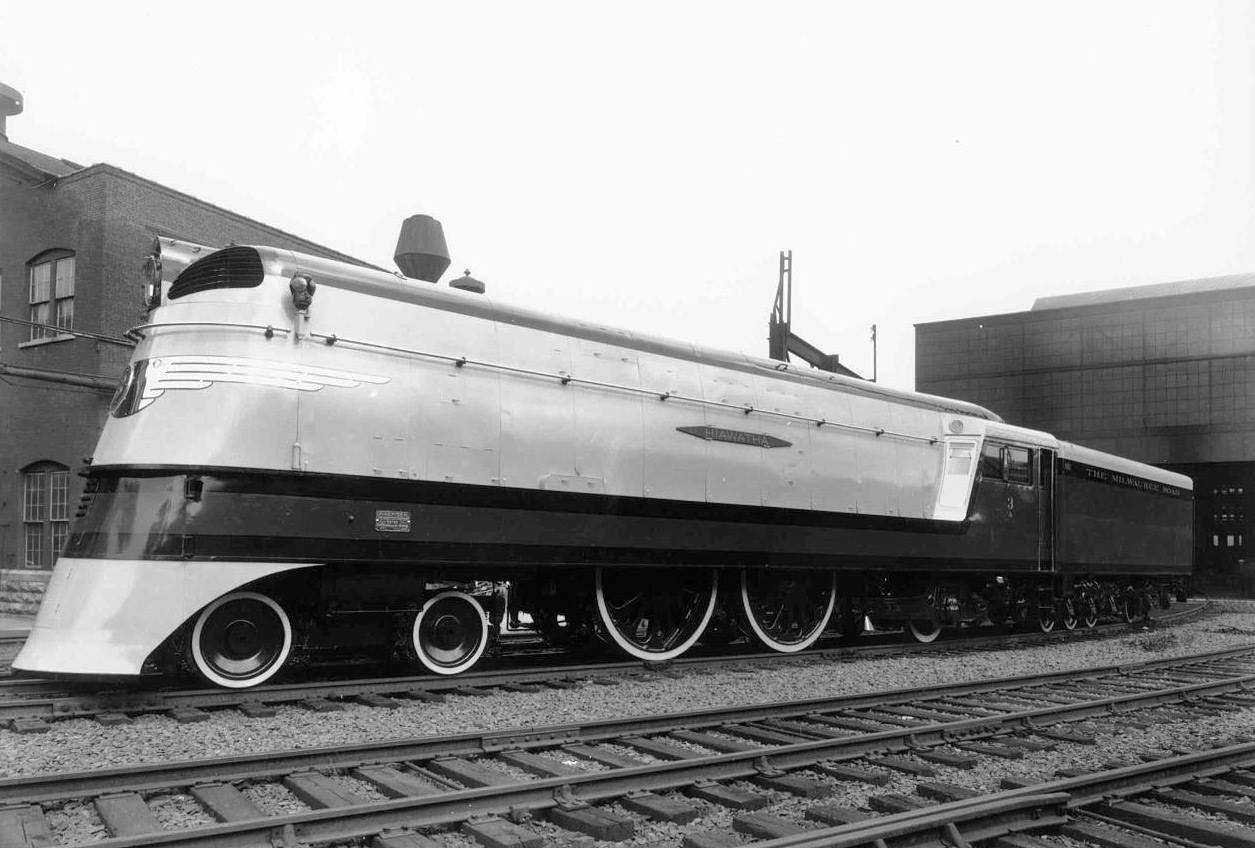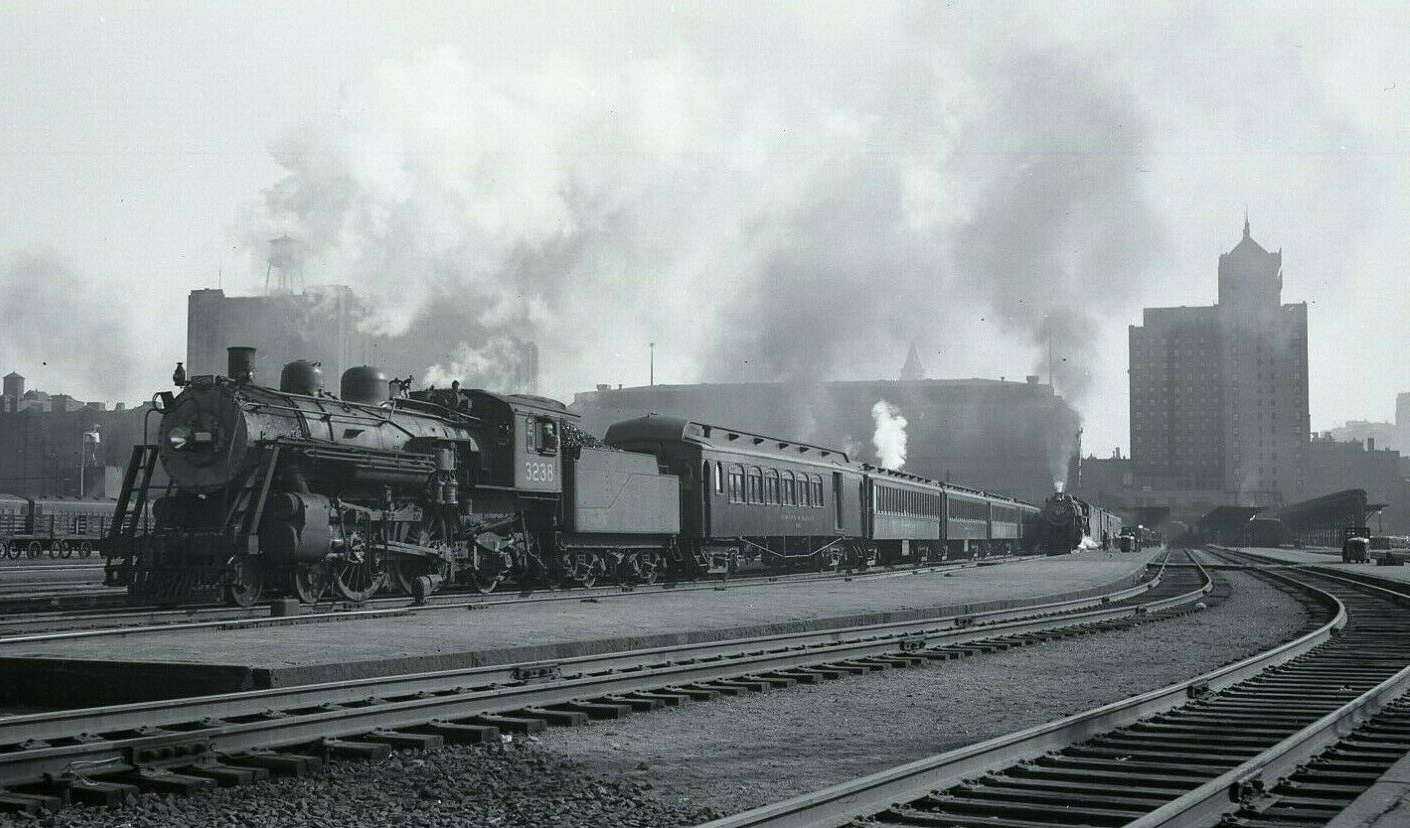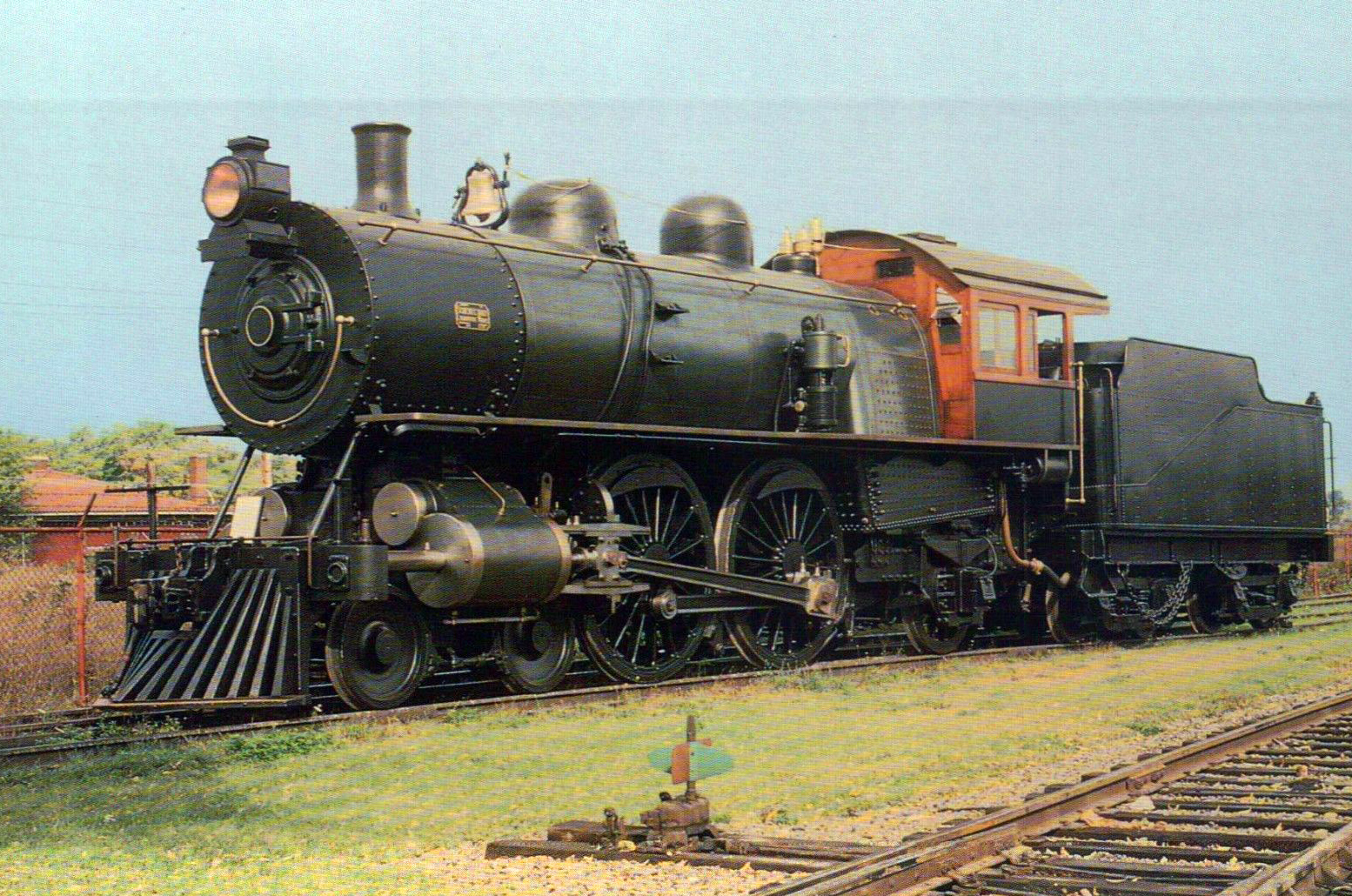4-4-2 "Atlantic" Locomotives: Photos, History, Survivors
Last revised: November 6, 2024
By: Adam Burns
The advent of the 4-4-2 design, commonly known as the Atlantic, marked a pivotal transition into what many consider the "modern" steam era. Innovations such as super-heaters and piston valves would soon follow, yet it was the Atlantic that first showcased the effective use of a trailing truck in mainline service.
Purpose-built for velocity, the Atlantic rapidly emerged as the preferred choice for hauling the opulent passenger trains of various railroads. Its design featured notably large driving wheels, enabling it to achieve breathtaking speeds of 80 to 100 mph.
More impressively, the Atlantic was capable of maintaining these speeds over extended stretches, embodying both the spirit and innovation of its time.
During its developmental phase, the iconic 4-4-2 swiftly acquired the name it is commonly known by today. Yet, several railroads and manufacturers opted to christen this model with their own unique descriptors.
Perhaps the most renowned of these was the series of Class A locomotives crafted by American Locomotive Company for the Milwaukee Road's inaugural "Hiawatha" streamliners.
As visually striking as they were swift, these locomotives have not only left a mark on the annals of railway history but continue to be cherished by enthusiasts and historians alike.
Photos
 An American Locomotive builder's photo featuring Milwaukee Road 4-4-2 #3 (Class A) during May, 1936 (one of four built). According to Jim Scribbins' book, "The Hiawatha Story," she was capable of cruising along at speeds between 100-120 mph.
An American Locomotive builder's photo featuring Milwaukee Road 4-4-2 #3 (Class A) during May, 1936 (one of four built). According to Jim Scribbins' book, "The Hiawatha Story," she was capable of cruising along at speeds between 100-120 mph.Development
Originating in the final decade of the 19th century, the Atlantic was a strategic innovation by railroads aiming to enhance speeds on their premier passenger services.
This type was essentially an evolution of the 4-4-0 American, augmented with a trailing truck. This addition was pivotal; it facilitated the incorporation of a substantially larger firebox typically positioned behind the driving wheels.
The result was a locomotive capable of generating greater horsepower and achieving notably higher speeds, redefining efficiency and performance in rail transport.
The debut of the 4-4-2 traces back to an innovative trial conducted by the New York, Providence & Boston Railroad (which later became part of the New Haven) in 1887.
In an experiment to enhance locomotive functionality, the company added an extra axle to the rear of a 4-4-0. This pioneering modification was initially aimed at more effectively dispersing the locomotive’s weight across an additional axle, rather than accommodating a larger firebox.
This strategic addition marked a significant evolution in locomotive design, paving the way for advancements that would later define modern train transport.
Hinkley Locomotive Works
In 1888, a year after the initial experimentation, the Hinkley Locomotive Works ventured into crafting its own 4-4-2 model. This unique center-cab design, equipped with a double-firebox, unfortunately did not meet expectations and was subsequently scrapped.
Nevertheless, the true potential of the 4-4-2 was realized shortly afterward when the Atlantic Coast Line endeavored to surpass the performance of the ubiquitous 4-4-0.
By integrating a larger firebox, the goal was to significantly enhance steam generation and power, propelling the 4-4-2 design into a new era of railway engineering excellence.
In 1894, after collaboration with Baldwin, a pivotal development in locomotive design was achieved with the creation of the now-iconic 4-4-2 model. Baldwin aptly named this groundbreaking locomotive the "Atlantic Type" in honor of the Atlantic Coast Line, who inspired its conception.
Success
This new design resonated deeply with the needs of the era's railroads, heralding a surge in popularity and effectiveness. By the end of its production run, more than 1,900 units of this influential model had been constructed, marking a significant chapter in railroad history.
While the "Atlantic" designation became synonymous with the 4-4-2 design among most railroads, some operators chose to bestow unique names on their versions of this design.
Milwaukee Road
The Milwaukee Road famously referred to their Class As simply as Milwaukees. Similarly, the Brooks Locomotive Company opted for a distinctive designation, calling their models Chautauquas, adding a personalized touch to the renowned locomotive type.
These varied names not only underscored the wide adoption and versatility of the 4-4-2 but also highlighted the regional pride and branding strategies of different rail companies.
During the 20th century, many Atlantics underwent significant technological enhancements, incorporating advancements like superheaters and piston valves.
Among these, the final models constructed are particularly celebrated. Manufactured in 1935 by the American Locomotive Company (Alco) for the Milwaukee Road, these Atlantics were arguably the zenith of their class—technologically sophisticated and incredibly fast.
These locomotives were also a visual marvel, thanks to the artistic collaboration between designer Otto Kuhler and the Milwaukee Road's own shop forces.
Adorned with a striking two-tone orange and cream livery, these 4-4-2s not only symbolized the pinnacle of railway engineering but also stood as icons of design elegance.
Designed for extraordinary performance, the Atlantics, capable of eclipsing 100 mph, graced the Milwaukee Road for only a few years before they were supplanted by the more powerful Hudson type. This pursuit of increased power essentially heralded the retirement of the Atlantic or their reassignment from mainline duties.
Despite the Milwaukee Road's examples being famed for their blistering speeds, it was actually the Santa Fe that operated the largest fleet, with 178 such locomotives.
Furthermore, by the time the Chicago, Milwaukee, St. Paul and Pacific Railroad (CMStP&P) acquired their Milwaukees between 1935 and 1937, the 4-4-2 had largely been eclipsed by more potent locomotive configurations, marking an evolutionary step in railway technology.
While Atlantics were renowned for their impressive speed, they lacked the horsepower and tractive effort of newer locomotive designs such as the Hudsons and Pacifics (4-6-2s).
Following the shift to all-steel car construction post-1910, railroads began phasing out the 4-4-2 in favor of these more powerful configurations, better suited to handle longer and heavier trains. Notably, the Milwaukee Road's Atlantics had been designated for relatively short and lightweight train sets.
Today, the legacy of the Atlantic types endures, with several preserved pieces showcased across the United States.
Preserved Examples
Notable examples include two from the former Pennsylvania Railroad housed at the Railroad Museum of Pennsylvania, an ex-Chicago & North Western at the Museum of Transportation in St. Louis, and another from the Southern Pacific at the Travel Town Museum in Los Angeles. These preserved locomotives offer a tangible link to a transformative era of railway history.
| Engine Number | Class | Wheel Arrangement | Track Gauge | Original Owner(s) | Current Location | Current Status | Builder Information | Notes |
|---|---|---|---|---|---|---|---|---|
| 45 (8085) | I-80a | 4-4-2 | 4' 8 ½" | Detroit & Lima Northern Railway (Detroit, Toledo & Ironton) | Greenfield Village (Dearborn, Michigan) | Display | Alco-Schenectady #25887 (3/1902) | Cosmetically restored. |
| 3025 | A-3 | 4-4-2 | 4' 8 ½" | SP | Travel Town Museum (Los Angeles) | Display | Alco-Schenectady #30005 (1904) | - |
| 1015 | D | 4-4-2 | 4' 8 ½" | Chicago & North Western | Museum of Transportation (St. Louis) | Display | Alco-Schenectady #5613 (1900) | - |
| 460 | E6s | 4-4-2 | 4' 8 ½" | PRR | Railroad Museum of Pennsylvania (Strasburg) | Display | PRR-Juniata Shops #2860 (1914) | Named 'Lindbergh Engine'. |
| "7002" | E-7s | 4-4-2 | 4'-8½" | PRR | Railroad Museum of Pennsylvania (Strasburg) | Cosmetically Restored | PRR (Juniata) #929, 08/1902 | Originally #8063. The actual #7002 (scrapped in 1935) was the fastest steam locomotive in the world when it reached 127.1 MPH on June 11, 1905. |
 Working suburban service, Boston & Maine 4-4-2 #3238 (J-1) departs Boston's North Station. These Atlantic's were manufactured by several of American Locomotive's subsidiary works in 1902 and heavily modified over the years.
Working suburban service, Boston & Maine 4-4-2 #3238 (J-1) departs Boston's North Station. These Atlantic's were manufactured by several of American Locomotive's subsidiary works in 1902 and heavily modified over the years.Currently, three 4-4-2 locomotives are operational, serving primarily in entertainment venues rather than as historical artifacts.
These include the 15-inch gauge #400 at the Buckley Old Engine Show in Buckley, Michigan; the 16-inch gauge "Whiskey River Railway" #12 at Little A-Merrick-A Amusement Park in Marshall, Wisconsin; and the "Harry J. Grant" Milwaukee County Zoo #1916, delighting visitors at its namesake zoo.
Additionally, there is exciting news from the Railroad Museum of Pennsylvania in Strasburg, where the Pennsylvania Class E6s #460 is reportedly undergoing restoration.
The full scope of this restoration project remains unclear, but it represents a significant effort to preserve a piece of railway history.
Sources
- Morrison, Tom. American Steam Locomotive In The Twentieth Century. Jefferson: McFarland & Company, Inc., 2019.
- Simpson, Walter. Steam Locomotive Energy Story, The. New York: American University Presses, 2021.
- Solomon, Brian. Alco Locomotives. Minneapolis: Voyageur Press, 2009.
- Solomon, Brian. Baldwin Locomotives. Minneapolis: Voyageur Press, 2009.
- Solomon, Brian. Classic Locomotives, Steam And Diesel Power in 700 Photographs. Minneapolis: Voyageur Press, 2013.
Recent Articles
-
Ohio - Whiskey - Train Rides
Dec 24, 25 05:47 PM
Ohio, with its rich history and scenic landscapes, offers an unusual yet delightful experience for spirit enthusiasts and travel aficionados alike: whiskey train rides. -
California Thomas The Train Rides
Dec 24, 25 05:44 PM
Held at various railroad museums and heritage railways across California, these events provide a unique opportunity for children and their families to engage with their favorite blue engine in real-li… -
Texas Thomas The Train Rides
Dec 24, 25 05:42 PM
In the heart of Texas, where everything is said to be bigger and bolder, lies an event that captures the imagination of children and families alike - A Day Out With Thomas.




